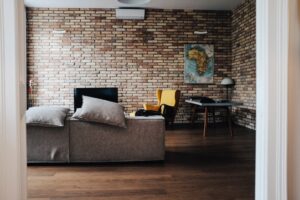Water Seeping From the Ground & Mold in the Crawl Space
Since it’s below the house, many disregard a wet crawl space as a natural phenomenon and not a real issue. However, contrary to common belief, a wet crawl space isn’t standard. A crawl space under any home should be arid at all times, even during rains or changing weather.
natural phenomenon and not a real issue. However, contrary to common belief, a wet crawl space isn’t standard. A crawl space under any home should be arid at all times, even during rains or changing weather.
Despite the vents in the crawl spaces, water can accumulate for various reasons and lead to mold growth. If your home has a wet or moldy crawl space, the following are some of the causes that can help you identify the issue as well as methods on how to fix it:
Gaps and Cracks in Foundation
Cracks or gaps in the foundation are the most common cause of wet and moldy crawl spaces. Homes ‘settle down’ as they age, causing wear and tear in the foundation. This wear and tear can cause cracks to appear. While the cracks are barely noticeable, they can lead to water seepage from the hydrostatic pressure into the home’s crawl space. Rain or humidity can also lead to water seeping into the crawl space through the small gaps in foundation stones.
The accumulated water can bring mold particles, which can also get inside the crawl space through the air vents. Since mold grows on damp surfaces, it can quickly grow and spread in the crawl space.
Cracked Water Lines
Water pipes running under or inside the structural features of homes are another common reason for damp and moldy crawl spaces. Since the water pipes are hidden, small leaks and cracks can stay unaddressed until they pose a more significant issue.
Gravity pulls water from pipe leaks and makes it get accumulated under the house in the crawl space. Even small leaks can be harmful to your home as they can cause water damage to structural features and promote mold growth in crawl spaces.
Clogged Drains
There can be various reasons for a clogged drain. Some people mistakenly dump kitchen waste or other kinds of waste that can block the sewers. Disposing of raked leaves is also a common reason for sewer lines to get clogged. Clogged drains can also occur as a result of heavy rainfall or flood.
As the sewer system gets overwhelmed and is unable to drain, it starts pushing water back up. Some of the water gets into the soil and crawl spaces through cracks or gaps in the foundation of homes. However, even after the clogged drain is opened and the water in water pipes is drained, the seeped water can stay in the soil and accumulate in the crawl space. If not taken care of, this seeped water can lead to moldy crawl space due to constant dampness.
Regular Wear and Tear
While homes are built to stay safe from water seepage and water damage, regular wear and tear can weaken these features as a house ages. Small gaps and cracks are common in the window, door, and vent frames and fixtures. Wear and tear in the walls or roof can also lead to water seepage and accumulation in the crawl space. The seeped and accumulated water can easily pave the way for a constantly wet crawl space and mold growth.
Weak Foundation and Improper Grading
The foundational features of any home are designed and built according to the region. Homes near water bodies have thicker foundation walls. Even if the weather of an area doesn’t require thick foundation walls, constructors should account for changing weather and possible disasters.
However, besides weak foundation, improper grading can also lead to water seepage into the crawl space. Grading requires removing excess water from the soil below and around the house. If the soil is too wet, it can become slippery and lead to a collapse of the entire structure of the house. Improper grading can eventually lead to excess water pushing its way into the home’s foundation and getting accumulated into the crawl space, turning it damp and moldy.
What Should You Do?
It is important to remove any mold growth in your home’s crawl spaces for a variety of reasons. Firstly, mold can grow rapidly. You might think mold is not dangerous as it is below the livable surface of the home, but it can very quickly grow and spread to livable areas.
However, even if only grown under the house surface, mold can cause structural damage to your home and can affect the mechanical and electrical features of your home too. On the surface, mold exposure can lead to mold poisoning.
To avoid mold growth in your home’s crawl space, you need to regularly ensure that it’s free of any moisture. Check the vents and ensure that nothing outside the house is blocking the flow of air. Inspecting your home’s structural features for possible water damage can also help avoid mold growth in the crawl space. If you find any moisture buildup or dampness in the crawl space, make sure to examine various areas of your home for all the possibilities of the causes mentioned above.
If you cannot identify the issue yourself, seeking immediate professional help can save your property from probable further damage. Call a restoration service, such as the 911 Restoration of New Orleans, for a thorough inspection of water accumulation in your home’s crawl space and safe mold removal.



